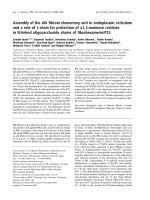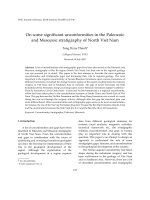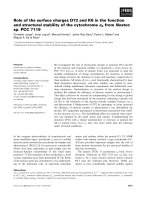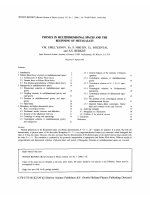Host viral interactions host factors in coronavirus replication and coronaviral strategies of immune evasion
Bạn đang xem bản rút gọn của tài liệu. Xem và tải ngay bản đầy đủ của tài liệu tại đây (5.09 MB, 220 trang )
HOST-VIRAL INTERACTIONS:
HOST FACTORS IN CORONAVIRUS REPLICATION AND
CORONAVIRAL STRATEGUES OF IMMUNE EVASION
WONG HUI HUI
(B. SC. (Hons), NUS)
A THESIS SUBMITTED FOR THE DEGREE OF
DOCTOR OF PHILOSOPHY
DEPARTMENT OF BIOCHEMISTRY
NATIONAL UNIVERSITY OF SINGAPORE
2012
i
Declaration
I hereby declare that this thesis is my original work and it has been written by me in its entirety. I
have duly acknowledged all the sources of information which have been used in the thesis.
__________________________
Wong Hui Hui
22
nd
October 2012
ii
Acknowledgements
I would like to extend my heartfelt gratitude to my supervisors, Dr Frederic Bard
and Associate Professor Liu Ding Xiang, for their mentorship, guidance and advice over the
years. I will also like to thank Dr. Manoj, Dr Slvie Alonso for their advice and critical feedback
during the thesis committee meeting.
Special thanks to all the wonderful co-workers from both FB and LDX laboratories, especially
Felicia, Yanxin, Ronghua, Violette, Joanne, Jasmine, for their friendship and encouragement and
Dr. Fang Shouguo, Dr. Yoshiyuki Yamada, Dr. Nasirudeen AMA, Dr. Pankaj Kumar, Dr.
Samuel Wang, Dr. Alexandre Chaumet and Dr Germaine Goh for their help and advice.
I would also like to thank IMCB (A*STAR) for awarding me the research scholarship under the
Scientific Staff Development Scheme.
This work would not have been possible without the unfailing support of my family –my
husband Alvin, my mum, Stella and my two brothers, Chen Wei and Yong Long.
iii
Table of Contents
Summary xii
List of Figures xiv
List of Tables xv
Publications xix
CHAPTER ONE: A LITERATURE REVIEW OF THE BIOLOGY OF CORONAVIRUS
1.1 CORONAVIRUS: AN OVERVIEW
1.1.1 Taxonomy……………………………………………………………………………… 2
1.1.2 Diseases of Coronaviruses.……………………………………………………………….4
1.1.3 Morphology and Structure of Coronavirus.………………………………………………6
1.1.4 Genome Organization of Coronavirus……………………………………………………7
1.1.5 Proteins encoded by Coronavirus…………………………………………………… …9
1.1.5.1.1 Structural proteins…………………………………………………………….9
1.1.5.1.2 Replicase and Non-structural proteins……………………………………….12
1.1.5.1.3 Accessory proteins………………………………………………………… 14
1.1.5.1.4 SARS Accessory proteins……………………………………………………14
1.1.6 The coronavirus life cycle……………………………………………………………….16
1.1.6.1 Attachment and Entry……………………………………………………… 16
1.1.6.2 Translation and assembly of replicase……………………………………….18
iv
1.1.6.3 Replication and Transcription………………………………………………19
1.1.6.4 Translation………………………………………………………………… 20
1.1.6.5 Virion assembly and Release……………………………………………… 22
1.1.7 Reverse Genetics and Genetic Manipulation of coronavirus……………………………23
1.2 VIRUS-HOST INTERACTIONS (I)
1.2.1 Host factors in coronavirus replication…………………………………………… … 24
1.2.1.1 Heterogenous nuclear ribonucleoprotein A1 (hnRNPA1)…………….….….25
1.2.1.2 Polypyrimidine-tract binding (PTB)……………………………………… 26
1.2.1.3 Poly (A) binding protein (PABP)………………………….…………….… 27
1.2.1.4 Mitochondria aconitase…………………………………………………… 28
1.2.1.5 DEAD box helicases……………………………………….……………… 29
1.2.1.6 Other cellular proteins…………………………………………………….….30
1.2.2 Cellular processes in coronavirus infection………………………………………….… 33
1.2.2.1 The role of cell cycle regulation in coronavirus replication…………………34
1.2.2.2 Ubiquitin-proteasome system and coronavirus infection……………………35
1.2.2.3 Autophagy, ERAD and early secretory pathway in DMV biogenesis……….36
1.2.2.4 Apoptosis and coronavirus infection……………………………………… 39
1.3 HOST-VIRAL INTERACTIONS (II): CORONAVIRUS AND THE INNATE
IMMUNE RESPONSE
1.3.1 Interferons………………………………………………………………………….……40
v
1.3.2 Pattern recognition receptors (PRRs)………………………………………….……… 43
1.3.3 The RIG-I-Like Helicase signaling pathway…………………………………….…… 46
1.3.4 Modulation of the innate immune pathways by coronaviruses………………………….48
1.4 OBJECTIVES
1.4 Objectives…… …………………………………………………………………………50
CHAPTER TWO: MATERIALS AND METHODS
2.1 MATERIALS
2.1.1 General reagents and chemicals……………………………………………….….…53
2.1.2 Enzymes…………………………………………………………………….………54
2.1.3 Antibodies………………………………………………………………………… 54
2.2 CELLS & VIRUSES
2.2.1 Cell culture………………………………………………………………………….55
2.2.2 Preparation of cell stock ……………………………………………………………55
2.2.3 Viruses…………………………………………………………………………… 57
2.2.4 Virus infection………………………………………………………………………58
2.2.5 Virus titration……………………………………………………………………….59
2.3 MOLECULAR CLONING
2.3.1 Preparation of competent cells………………………………………………………60
2.3.2 Polymerase chain reaction………………………………………………………… 60
2.3.3 DNA Agarose gel electrophoresis………………………………………………… 62
vi
2.3.4 Gel purification…………………………………………………………………….62
2.3.5 Recombinant DNA technique – construction of plasmids…………………………63
2.3.6 Plasmid purification……………………………………………………………… 64
2.3.7 DNA sequencing……………………………………………………………….… 64
2.3.8 Plasmids……………………………………………………………………………65
2.4 RNA MANIPULATION
2.4.1 Extraction of total RNA from mammalian cells…………………………………….66
2.4.2 Reverse transcription……………………………………………………………… 67
2.4.3 Quantitative real-time PCR (qPCR)……………………………………………… 68
2.4.4 RNA interference (RNAI)………………………………………………………… 69
2.5 GENOME WIDE RNAI SCREEN
2.5.1 Screen setup…………………………………………………………………………70
2.5.2 Data formatting, normalization and screen quality control…………………………70
2.5.3 Z score calculation………………………………………………………………… 71
2.5.4 Deconvoluted screen……………………………………………………………… 72
2.5.5 Bioinformatics Analysis: Gene annotation and protein networks………………….72
2.6 PROTEIN EXPRESSION AND ANALYSIS
2.6.1 Transient expression of plasmid DNA in mammalian cells……………………….73
2.6.2 SDS-PAGE……………………………………………………………………… 74
2.6.3 Western Blot Analysis…………………………………………………………… 74
2.6.4 Native-PAGE…………………………………………………………………… 74
2.6.5 Co-immunoprecipitation………………………………………………………… 75
vii
2.7 LUCIFERASE ASSAYS
2.7.1 IFN-β reporter assay……………………………………………………………… 76
2.7.2 Luciferase assay with IBV-Luc………………………………… …………….….77
2.8 IMMUNOFLUORESCENCE…………………………………………………………….77
2.9 SUBCELLULAR FRACTIONATION……………………………………………….… 78
CHAPTER THREE: GENOME WIDE RNAI SCREEN FOR CELLULAR FACTORS IN
CORONAVIRUS INFECTION
3.1 INTRODUCTION…………………………………………………………………………80
3.2 RESULTS (I): GENOME WIDE RNAI SCREEN REVEAL CELLULAR FACTORS
INVOLVED IN CORONAVIRUS INFECTION
3.2.1 Optimization of genome wide RNAi screen………………………………… ……82
3.2.2 86 cellular cofactors of coronavirus validated by at least two independent
RNA……………………………………………………………………………… 87
3.2.3 Bioinformatics analysis of screen hits………… ………………………………….91
3.2.4 Comparison of screen with SARS interactome………….…………………………93
3.2.5 Screen recovered genes associated with cellular processes/molecular functions
known to modulate coronavirus infection……….…………………………………96
3.2.6 Ubiquitin-proteasome pathway and ER and associated degradation in coronavirus
replication…………………………………………………………………………103
viii
3.3 RESULTS (II): CHARACTERIZATION OF THE ROLE OF VCP IN IBV
REPLICATION
3.3.1 VCP is involved in the early stages of virus replication………………………….106
3.3.2 VCP is not required for viral attachment to cell surface and virus entry…………108
3.3.3 Silencing of VCP inhibits disassembly of virus particles…………………………110
3.3.4 Silencing of VCP results in accumulation of virus in early endosomal fractions 112
3.3.5 N protein degradation as an assay to detect genes involved in early replication….114
3.4 DISCUSSION
CHAPTER FOUR: HOST-VIRUS INTERACTION (II): CHARACTERISATION OF
HOST ANTIVIRAL MECHANISMS AGAINST CORONAVIRUS INFECTION AND
CORONAVIRAL STRATEGIES OF IMMUNE EVASION
4.1 CHARACTERIZATION OF HOST ANTIVIRAL MECHANISMS AGAINST
CORONAVIRUS INFECTION
4.1.1 INTRODUCTION………….……………………… ………………………….122
4.1.2 RESULTS .……………………………… ………………………………… …124
4.1.2.1 IBV is sensitive to IFN activation………………………………… …………124
4.1.2.2 IBV infection weakly induce IFN and IFN-stimulated genes…………………125
4.1.2.3 IBV infection is associated with inefficient IRF3 activation………………….126
ix
4.1.2.4 Lack of IFN induction in IBV-infected cells was not due to defective inherent
IFN signaling in host cells……………………………………………………128
4.1.2.5 Overexpression of cytoplasmic dsRNA receptors RIG-I, Mda5 and TLR3 failed
to suppress viral infection……………………………………………….……132
4.1.2.6 IBV infection was not modulated by over-expression of TLR3…………… 136
4.1.2.7 IBV replication up-regulates low levels of RIG-I, Mda5…………………….138
4.1.2.8 IBV replication partially inhibits IFN response at late stages of infection… 139
4.1.2.9 Expression of IFN and ISGs during IBV infection is cell-type dependent… 141
4.1.2.10 IBV infection did not lead to establishment of an effective anti-viral state
in infected cells where IFNs are transcriptionally activated…………………145
4.1.3 DISCUSSION……………………………………………………………………147
4.2 SARS ORF8B AND ORF8AB ARE NOVEL INTERFERON ANTAGONISTS
4.2.1 INTRODUCTION………………………………………………………………151
4.2.2 RESULTS……………………………………………………………………… 153
4.2.2.1 SARS protein 8b and 8ab interacts physically with IRF3…………………….153
4.2.2.2 The DNA binding domain of IRF3 is dispensable for its interaction with protein
8b……………………………………………… …………………………….155
4.2.2.3 Suppression of IRF3 activation by protein 8b and 8ab……………………… 157
4.2.2.4 Expression of SARS8b and 8ab decreased IFN-β promoter activation in response
to poly (I:C) and VISA stimulation……………………………………………158
x
4.2.2.5 Expression of SARS8b and 8ab decreased transcriptional induction of IFN-β and
ISGs………………………………………………………………………… 160
4.2.2.6 Expression of 8b allowed IBV to replicate more efficiently in the presence of
poly (I:C) stimulate………………………………… ………… 162
4.2.3 DISCUSSION…………………………………………………………………….166
CHAPTER FIVE: GENERAL DISCUSSION AND FUTURE DIRECTIONS
5.1 GENOME-WIDE SCREEN REVEALS CELLULAR CO-FACTORS IN
CORONAVIRUS INFECTION
5.1.1 Main conclusions……………………………………………………………………….170
5.1.2 General discussions…………………………………………………………………….171
5.1.2.1 The use of RNAi screen to identify cellular cofactors involved in coronavirus
replication ……,,…………………………………………………………… 171
5.1.2.2 The role of VCP in virus and host endosomal trafficking………………….…172
5.1.2.3 Involvement of ERAD and UPS players in coronavirus replication and host
endocytic pathway………………………………………………………….…173
5.1.2.4 Other significant findings………………………………………………….….173
5.1.3 Future directions……………………………………………………………………… 174
xi
5.2 CHARACTERIZATION OF HOST INNATE RESPONSE TOWARDS IBV
INFECTION AND CORONAVIRAL COUNTERSTRATEGIES OF IMMUNE
EVASION FINAL REMARKS
5.2.1 Main conclusions…………………………………………………………………… 175
5.2.2 General discussion
5.2.2.1 Coronavirus passive evasion of immune detection during IBV infection…….177
5.2.2.2 SARS ORF8 as a novel IFN antagonist……………………………………….178
5.2.3 Future directions…………………………… ……………………………………… 179
5.3 FINAL REMARKS………………………………………………………………………180
REFERENCES……………………………………………………………………………… 181
xii
Summary
Be it the conscription of cofactors for replication, perturbation of cellular processes to create an
advantageous microenvironment, or the necessary subversion of immune defenses for the
purpose of effective propagation, the intricate interaction between the virus and its host is
fundamental to the determination of virulence. An improved understanding of these events will
not only allows us to gain new insights into the complicated field of coronavirus biology, but
may also provide new directions for therapeutic interventions.
Using primarily the prototypic IBV as our model coronavirus, we explored two key aspects of
virus-host interactions in this dissertation. Firstly, through a genome-wide RNA interference
screen, we identified critical cellular cofactors that have roles in modulating coronavirus
replication. While some of these factors are already known to be implicated in coronavirus
replication, many others are novel cofactors that have yet to be characterized. Among the cellular
host factors identified, the role of valosin containing protein (VCP) in the modulation of
coronavirus replication was examined in greater detail. From our study, it was found that VCP is
required for the efficient transfer of viral particles from early endosomal compartments to the
host cytosol where viral replication occur.
In the second part of the thesis, we focused on understanding the interplay between coronavirus
infection and host cell innate immune response. Through examining the status of interferon
(IFN) activation in different cell lines susceptible to IBV infection, it was observed that IBV
counteracts the effective activation of the host anti-viral mechanisms via distinct strategies that
xiii
include passive evasion of immune detection, as well as active inhibition of events leading to the
establishment of an anti-viral state. Lastly, through a screen for interaction between IRF3, a key
transcription factor regulating IFN activation in host cells and SARS-Coronavirus encoded
ORFs, we identified SARS ORF8 to be novel antagonist of IFN signaling. As SARS ORF8 binds
to the self-association domain in IRF3, we hypothesized that by disrupting IRF3
homodimerization that is required for its nuclear translocation, SARS ORF8 prevents the
transcriptional activation of IFN mediated by IRF3. (344 words)
xiv
LIST OF TABLES
Table 1.1: Representative species of Alpha- Beta- and Gamma- coronaviruses
Table 1.2: A summary of the known functions of accessory proteins encoded by SARS-CoV
Table 1.3: Known cellular receptors utilized by coronaviruses
Table 1.4: Cooperative interactions between structural proteins drive virion assembly
Table 1.5: Cellular proteins interacting with coronavirus proteins
Table 1.6: The specificity of RIG-I-like receptors in virus recognition
Table 2.1: List of reagents and chemicals
Table 2.2: List of primary and secondary antibodies
Table 2.3 List of primers for polymerase chain reaction
Table 2.4 Optimized conditions for siRNA transfections
Table 3.1: List of cellular cofactors that were validated by at least two independent siRNAs
xv
LIST OF FIGURES
Figure 1-1: Taxonomical classification of coronaviruses
Figure 1-2: Structure of coronavirus morphology
Figure 1-3: Genome organization of Coronaviruses
Figure 1-4: The domain organization of the replicase protein
Figure 1-5: Subgenomic mRNAs of IBV
Figure 1-6: A three-step model for discontinuous transcription
Figure 1-7: Effects of defective early secretory pathway on coronavirus replication
and DMV biogenesis
Figure 1-8: The JAK-STAT pathway
Figure 1-9: MyD88 dependent or MyD88 independent pathway in TLR signaling
Figure 1-10: RLH signaling in response to viral infections
Figure 1-11: Coronavirus interacts with the innate immune response at multiple levels
Figure 3-1: The use renilla and firefly luciferase activity as markers for cell numbers
and virus replication efficiency respectively
Figure 3-2: Distribution of genes in genome wide screen
Figure 3-4: Novel hit selection method reveals cellular cofactors for coronavirus
replication
xvi
Figure 3-5: Gene Ontology analysis of validated screen hits
Figure 3-6: Cellular map of screen hits
Figure 3-7: Comparison between IBV genome-wide siRNA screen and SARS yeast-2-
hybrid screen
Figure 3-8: Genome wide screen reveals proteins or proteins involved in pathways
previously implicated in coronavirus infection
Figure 3-9: RNAi screen identified components of the early secretory pathway as
cofactors for IBV replication
Figure 3-10: GBF1 and ARF1 are involved in IBV replication
Figure 3-11: GBF1 and Arf1 suppress replication of type I and type 2 dengue viruses
Figure 3-12: Genes involved in UPS and ERAD regulation identified from the RNAi
screen
Figure 3-13: Depletion of VCP affects replication at early stages
Figure 3-14: VCP is not required for virus attachment and entry
Figure 3-15: Depletion of VCP resulted in N protein accumulation at early time points
Figure 3-16: Depletion of VCP resulted in accumulation of viral particles in early
endosome vesicles
Figure 3-17: Lack if IBV N degradation is a marker for disruption to early replication
events of coronavirus infection
Figure 4-1: Anti-innate response strategies adopted by viruses
xvii
Figure 4-2: IBV infection is sensitive to IFN activation
Figure 4-3: IBV infection failed to induce high levels of IFN and ISGs
Figure 4-4: IBV infection did not lead to IRF3 activation
Figure 4-5: IBV replication was inhibited by poly (I:C) treatment
Figure 4-6 H1299 and Huh-7 cells can produce biologically active IFNs in the
presence of poly (I:C) stimulation
Figure 4-7: The effects of transient expression of RIG-I, MDA5, MAVS and IRF35D
on IBV replication
Figure 4-8: Over-expression of RIG-I and MDA5 reduced dengue replication
Figure 4-9: IBV replicate efficiently in the presence of RIG-I and MDA5 over-
expression
Figure 4-10: Effect of TLR3 over-expression on IBV replication
Figure 4-11: Comparison of RIG-I and MDA5 expression in IBV and dengue infected
cells
Figure 4-12: Effect of IBV infection on IFN activation
Figure 4-13: Up-regulation of ISGs, RIG-I and MDA5 in IBV-infected Vero cells
xviii
Figure 4-14: Up-regulation of IFN-β and ISG56 by IBV infection is cell-type
dependent
Figure 4-15: Reduction assay using supernatant from IBV-infected H1299, Huh-7,
293T and Cos-7 cells
Figure 4-16: SARS 8b and SARS 8ab interact physically with IRF3
Figure 4-17: Mapping the interaction domain in IRF3
Figure 4-18 Over-expression of SARS 8b and 8ab inhibit poly (I:C)-induced IRF3
activation
Figure 4-19 Protein 8b and 8ab suppressed poly (I:C)-induced IFN-β promoter activation
Figure 4-20 Protein 8b and 8ab suppressed transcriptional activation of IFN-β, and other
ISGs in response to poly (I:C) stimulation
Figure 4-21 Growth kinetics of recombinant viruses
Figure 4-22: rIBV-8b and -8ab replicated more efficiently in poly (I:C) treated cells
xix
List of Publications
1. Wong HH, Kumar P, Tay FP, D Moreau, Liu DX, Bard F (2012) Genome wide screen
reveals cellular factors in coronavirus replication (Manuscript in preparation)
2. Nasirudeen AM, Wong HH, Thien P, Xu S, Lam KP, Liu DX. (2011) RIG-I, MDA5 and
TLR3 synergistically play an important role in restriction of dengue virus infection. PLos
Negl Trop Dis 5:e926
3. Le TM, Wong HH, Tay FP, Fang S, Keng CT, et al. (2007) Expression, post-
translational modification and biochemical characterization of proteins encoded by
subgenomic mRNA8 of the severe acute respiratory syndrome coronavirus. FEBS J 274:
4211-4222.
Abstract
Be it the conscription of cofactors for replication, perturbation of cellular processes to create an
advantageous microenvironment, or the necessary subversion of immune defenses for the
purpose of effective propagation, the intricate interaction between the virus and its host is
fundamental to the determination of virulence. An improved understanding of these events will
not only allows us to gain new insights into the complicated field of coronavirus biology, but
may also provide new directions for therapeutic interventions. Therefore, using primarily the
prototypic IBV as our model coronavirus, we aspire to explore two aspects of virus host
interactions in this dissertation. Firstly, through a genome wide RNA interference screen, we
identified critical cellular cofactors that have roles in modulating coronavirus replication. In the
second part of the thesis, we focused on understanding the interplay between coronavirus
infection and host cell innate immune response. Coronaviral strategies of immune evasion were
also examined. (151 words)
1
CHAPTER ONE: LITERATURE REVIEW OF BIOLOGY OF
CORONAVIRUS
2
1.1: CORONAVIRUS: AN OVERVIEW
1.1.1 Taxonomy
Coronaviruses are species of enveloped RNA virus belonging to the subfamily of
Coronavirinae in the family of Coronaviridae. Together with the Arteviridae and
Roniviridae family of viruses, they are classified in the order of Nidovirales [1]. The
word ‘nidus’, meaning ‘nest’ in Latin is in reference to the production of 3’ nested
set of subgenomic mRNAs by these families of viruses during transcription.
Depending on their antigenic properties, gene sequences/organization and conserved
domains in their replicase gene, this subfamily can be further classified into three
genera: alpha-, beta-, and gamma- coronavirus [2].
Figure 1.1: Taxonomical classification of coronaviruses
Alphacoronaviruses and betacoronaviruses comprise of diverse coronavirus species
infecting a wide range of mammalian hosts (pigs, cattle, cats, dogs, bats) including
human. HCoV-229E and HCoV-NL63 are alphacoronaviruses while HCoV-HKU9,
Nidovirales
Coronaviridae
Coronavirinae
Alphacoronavirus
Betacoronavirus
Gammacoronavirus Torovirinae
Arteriviridae
Roniviridae
Genus Sub-family Family Order
3
HCoV-OC43 and severe respiratory syndrome coronavirus (SARS-CoV) belongs to
the latter. In contrast, the gammacoronaviruses group is made up of mainly avian
coronaviruses and includes species like infectious bronchitis virus of fowls and other
coronaviruses of birds. Selected representative species of each genus are presented in
the table below.
Table 1.1: Representative species of Alpha- Beta- and Gamma- coronaviruses
Genus
Representative species
Host
Alphacoronavirus
Transmissible gastroenteritis virus
Porcine Epidemic Diarrhea Coronavirus
Pigs
Feline Coronavirus (serotype 2)
Cats
Bovine Coronavirus
Cattle
Human coronavirus 229E, Human coronavirus
NL63
Human
Betacoronavirus
Mouse Hepatitis Virus
Mouse
Severe Acute Respiratory syndrome Coronavirus
Human coronavirus O43
Human
Bat Coronavirus HKU9
Bats
Gammacoronavirus
Avian Infectious Bronchitis Virus
Chickens
SW1 Virus
Beluga Whale
4
1.1.2 Diseases of Coronavirus
Coronavirus is the etiologic agent for the Severe Respiratory Syndrome (SARS)
outbreak in 2002-2003 which caused approximately 10% mortality in the 8000
people infected worldwide [3]. Apart from causing acute respiratory disease, they
also infect many systemic organs such as gastrointestinal tract, liver, kidney and
brain [4], leading to symptoms such as fever, dyspnae, lympopenia, diarrhea and
lower respiratory tract infection [5].
In contrast, other human coronaviruses such as HCoV-229E, HCoV-OC43, NL63
and HKU1 cause only mild symptoms and are collectively responsible for about 10-
30% of common colds. Despite speculations of them associating with more severe
clinical outcomes such as multiple sclerosis, hepatitis and gastritis in immuno-
compromised individuals, infants and the elderly [6,7,8], they are generally perceived
as harmless and left limiting.
Murine coronaviruses are the most extensively studied coronavirus prior to the SARS
outbreak in 2003. There are multiple strains of murine coronaviruses, which differ in
both tropism and virulence. Highly epidemic, they spread quickly among population
causing respiratory, enteric, neurologic and nephritic diseases in rodents and in
particular laboratory mice that are kept in closed colonies. As neurotrophic strains
such as JHM and A59 cause acute encephalitis and chronic demyelination, these are









